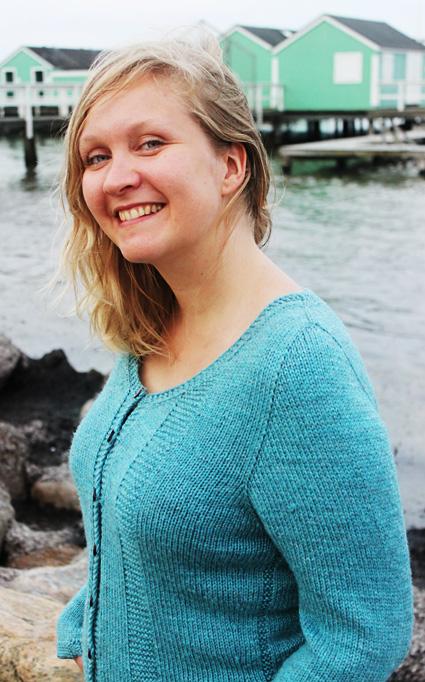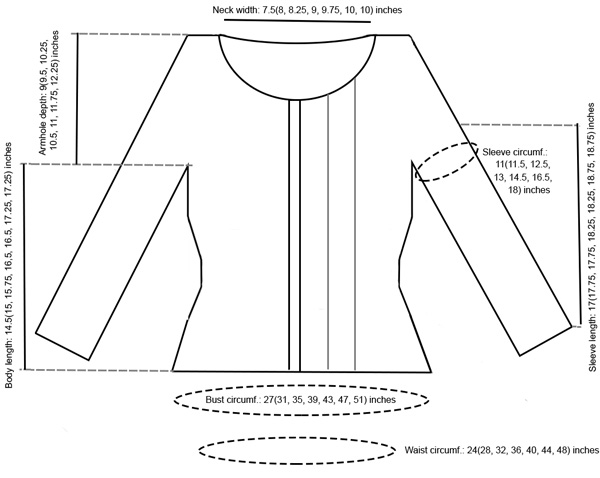

|
|
|

This yarn, in my absolute favorite color, had been in my stash for quite a while. I wanted it to become something perfect! Being a big sweater knitter, I was just waiting for the right pattern to come along. When I discovered the contiguous sleeve method developed by Susie Myers, I couldn't believe my luck -- a top-down sweater, with set in style sleeves, without any picking up of stitches along the armhole edge or even seaming! I wanted the garment to be simple, yet interesting. In the beginning I didn't really have a plan as such -- I just started knitting, using the contiguous method, and the garment grew in my hands. Dreading the long stretches of stockinette stitch on an adult sweater, I added some garter stitch details. As the garment grew, so grew my expectations to the final result. The cardigan turned out just like I wanted it. The garter stitch accents make for an interesting knit, while also helping to keep track of where you are. Waist shaping on the back is hidden in the garter stitch panel, which emphasizes the waist. About 2 inches of negative ease is recommended. |
||
|
|
 |
Tweet
 |
|
SIZE |
|
|
FINISHED MEASUREMENTS |
|
MATERIALS Notions |
|
GAUGE |
| 21 sts/28 rows = 4" in stockinette stitch 20 sts/36 rows = 4" in garter stitch |
|
PATTERN NOTES |
|
Figure eight cast on: Holding the two needles together, wrap the yarn around them in a figure eight motion. So: lay the yarn over the needle farthest away from you, the working end between the needles. Wrap the yarn under and around the needle closest to you, then bring it up between the needles. Wrap it over and around the needle away from you. Repeat until you have the desired number of stitches. |
|
DIRECTIONS OR: using your preferred provisional cast on method, cast on 4 sts. Set up and place markers [WS]: Slpwyf, k3, (buttonband sts), pm, pm (left front sts will be between these two markers), p1 (shoulder st), pm, p1 (left back st), pm, (k1, kfb) 12[14, 14, 15, 17, 17, 17] times, k2[1, 1, 2, 0, 2, 2] (back garter panel), pm, p1 (right back st), pm, p1 (shoulder st), pm, pm (right front sts will be between these two markers), k4 (buttonband sts). 4 sts for each buttonband; 1 st for each shoulder, 1 st at each side of back; back garter st panel 38[43, 43, 47, 51, 53, 53] sts; 50[55, 55, 59, 63, 65, 65] sts in total. Work shoulder increases: Set up row [RS]: Slpwyf, k3, sl first marker, M1R, sm, k1, sm, M1L, k1, sm, k to m, sm, k1, M1R, sm, k1, sl first marker, M1L, sm, k4. 54[59, 59, 63, 67, 69, 69] sts. 4 sts increased. Row 1 [WS]: Slpwyf, k3, sm, p to m, M1LP, sm, p1, sm, M1RP, p to m, sm, k to m, sm, p to m, M1LP, sm, p1, sm, M1RP, p to m, sm, k4. 58[63, 63, 67, 71, 73, 73] sts. 4 sts increased. Repeat Rows 1 and 2 2[2, 4, 5, 5, 5, 6] times more, then Row 1 once more. 82[87, 103, 115, 119, 121, 129] sts. 20[20, 36, 44, 44, 44, 52] sts increased. Row 3 [RS]: Slpwyf, k3, sm, k to m, sm, M1L, k to m, M1R, sm, (k to m, sm) 3 times, sm, M1L, k to m, M1R, sm, k to m, sm, k4. 86[91, 107, 119, 123, 125, 133] sts. 4 sts increased. Repeat Rows 3 and 4 2[3, 3, 4, 5, 7, 7] more times. Note: Front increases are made one st outside the buttonband on every RS row. Row 5 [RS]: Slpwyf, k3, sm, k1, M1L, k to m, sm, M1L, k to m, M1R, sm, (k to m, sm) 3 times, M1L, k to m, M1R, k to one st before m, M1R, k1, sm, k4. 100[109, 125, 141, 149, 159, 167] sts. 6 sts increased. Repeat Rows 5 and 6 3 more times. Repeat Rows 21 and 22 1[3, 3, 5, 7, 8, 10] times more. Rep Rows 21-24 once more. There are 8[10, 10, 12, 14, 15, 17] sts between the buttonband and the front garter panel. There should now be 4 sts for each buttonband; 26[28, 32, 36, 38, 39, 43] sts for each front section; 39[45, 45, 51, 57, 63, 67] sts for each sleeve; 56[61, 69, 77, 81, 83, 87] sts across the back. 194[215, 231, 259, 279, 295, 315] total sts. Turn buttonband: Buttonhole: Body and sleeve increases: Row 27 [RS]: Slpwyf, k4, work in pattern to one st before first sleeve m, *M1R, k1, sm, M1L, k to m, M1R, sm, k1, M1L*, work in pattern to one st before next sleeve m, repeat from * to *, work in pattern to end. 8 sts increased. Repeat Rows 27 and 28 4[4, 4, 4, 4, 6, 10] more times. Body increases only: Repeat Rows 29 and 30 1[3, 4, 5, 8, 10, 10] more times. Work straight in pattern for 2 inches, ending with a WS row. Decrease row [RS]: Work in pattern to 7 sts before side m, ssk, work in pattern to back garter panel marker, k1, k2tog, work in pattern to 3 sts before next marker, ssk, work in pattern to 5 sts after side m, k2tog, work in pattern to end. 4 sts decreased. Work the Decrease row every 1.25 inches (approximately every 8th row) a total of 4 times. Work straight for 1.5 inches. Increase row [RS]: Work in pattern to 6 sts before side m, M1L, work to back garter panel marker, k1, kfb, work in pattern to 1 st before next marker, kfb, work in pattern to 6 sts after side m, M1R, work in pattern to end. Repeat the Increase row every 1.25 inches a total of 4 times. Ribbing: Set up row [WS]: Using backwards loop cast on, CO 7 sts. Row 1 [RS]: Slpwyf, k5, k2tog (k the last st together with the first st on the body), turn. Repeat Rows 1 and 2 until all body sts have been worked. Change to US#6 needles, and using Magic Loop method or DPNs, pick up and knit 2 sts from the cast on body sts, knit sleeve sts, pick up and knit 2 more sts from the cast on body sts, pm. 57[61, 63, 67, 75, 85, 95] sts on needles. Continue working in the round in st st until sleeve measures 4 inches from underarm. Decrease rnd: k1, k2tog, k until 3 sts before m, ssk. Sleeve ribbing: Set up row [WS]: Using a provisional cast on, CO 5 sts. Row 1 [RS]: Slpwyf, k3, k2tog (k the last st together with the first st on the sleeve), turn. Rep Rows 1 and 2 until all sleeve sts have been worked, graft the sts together with the provisionally cast on sts. |
 |
|
FINISHING |
| ABOUT THE DESIGNER |
|
Dieuwke is a spinner and a knitter with a way too big stash. She has always got an idea on the needles, and packs for at least 3 different knitting projects when going on a weekend trip. |
|
Pattern & images © 2013 Dieuwke van Mulligen. Contact Dieuwke |